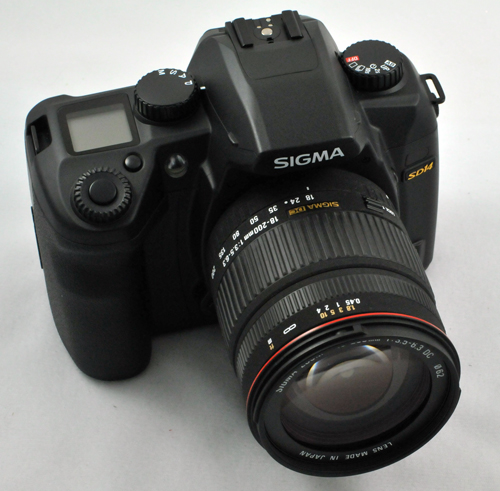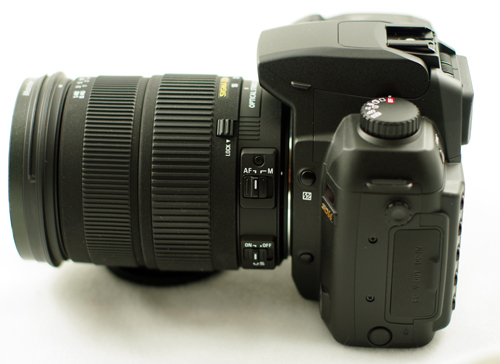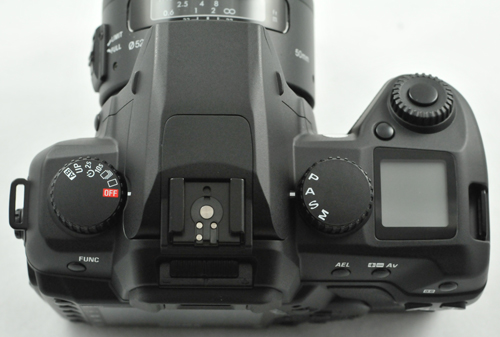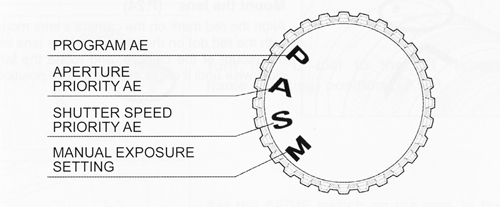Sigma SD14: Quick Look at a Quirky Wonder
by Wesley Fink on June 3, 2008 4:20 AM EST- Posted in
- Digital Camera
Operation and Controls

The Sigma SD14 is a medium-sized camera. It is much larger than the tiny Canon XSi/XTi or the Nikon D60/D40. Compared to prosumer modes, it is about the same width as the Nikon D300 or Canon D40 but not quite as tall. Here it is fitted with the non-OS version of the Sigma 18-200mm f3.5-6.3, which is one of the smallest super-zooms we have seen on the market. The SD14 appears well built, and Sigma states it is built around a stainless-steel frame.

The lens release lock is on the left facing the camera, and you can see the depth of field preview button on the right side of the mount in this view. The top button is the flash compensation button, used with the dial around the shutter release to adjust the output of the pop-up flash. In this view the SD14 is mounted with the larger 18-200mm f3.5-6.3 OS lens.

The SD14 features a simple menu and controls. The ISO/WB button just above the arrow pad brings up a screen to adjust ISO, White Balance, Quality (RAW, JPEG), and Resolution (Image Size). The menu itself does not even need sub-categories and all the adjustments fill just three screens of information on a single menu. The only thing that does not fit this simple approach is the strange FUNC button to the left of the viewfinder that brings up eight additional functions (in the latest firmware versions) adjusted by selecting the function, holding in the FUNC button and rotating the front dial.

The top has a dial on each side plus a small LCD screen. The LCD screen reports basic info such as frame and battery status. It is also used with many of the buttons and the dial around the shutter button to adjust less frequently used options.

For example to enable ISO 1600 you hit the function button six times, then push it a seventh time and hold in the FUNC button. You will see def (default) on the top LCD. Turn the front dial one click while holding the FUNC button until you bring up the ETD (Extended) function in the top LCD. You then have the option of ISO 1600 added to the ISO options. It is really easier than it sounds, and with the firmware version 1.05 and later you have an ISO 50 option as well.

The top left dial is called the Drive Dial and it is unusual in that it is also used to turn the SD14 on and off. You can also select drive mode, one of two self-timer modes, mirror lock-up, and auto bracketing.

The top right Mode Dial could not be simpler. You can select Program, Aperture Priority, Shutter Priority, or Manual. That's it as there are no scene modes. Metering is selectable from a top rear button for spot, center-weighted, or the default 8-segment matrix.
Sigma SD14 marketing materials make a huge deal out of how simple the SD14 is as a camera. In general that is certainly true, but we have to wonder if that is the case because Sigma didn't have the internal resources to build anything more sophisticated. After using the slow SD14 you will understand exactly what is being said here.
You can do almost anything you need to take better photographs with the Sigma, and the options are here that are often missing on competing
cameras - like mirror lock-up, 2s self-timer option, illuminated top LCD, and selectable metering. However, you can't
do anything fast, since the internal processing and write times are extremely slow. Once we changed to a CF card that was a better match to the SD14 the camera was ready to use about a second after turning it on - that is certainly acceptable.
However, in shooting the RAW images for
the noise comparison on the next page it was 2 to 3 seconds of solid red just to do enough
to display the image on the rear 2.5" LCD, then about 6 seconds more of blinking
to write the 13.3MB RAW file. If you choose JPEG processing it takes even longer than
RAW. In fairness it is possible to take another picture while the camera is writing, but the processing speeds are slow and the small buffer can only hold about 6 images before forcing a wait for write. The result is that capturing images with the SD14 is a slower process than with competing cameras.
However, there is more to this than just the slow processing speeds of the SD14. No one but Sigma had the guts to try to build a Foveon-sensor camera. In fact Sigma has just introduced another Foveon-sensor camera - the first DSLR-sensor point-and-shoot - in the Sigma DP1. If you are ready to ask, "why did they bother?", we hope to show you on the next two pages.










40 Comments
View All Comments
cheetah2k - Wednesday, June 4, 2008 - link
I've bought over 100 memory cards on ebay, and all at respectable prices (here in Australia we still pay about US$30 for 2GB!) and I've never had a problem. I just purchased a nice 8Gb Sandisk Ultra III CF for my Sony A350, 4Gb CF Ducati, and 8gb Sandisk MicroSD just recently, and again without any errors or faults.The only way to test these cards also, is to fill em up to the hilt with data. At 14MP, and 1 day of continuous shooting, I easily fill 8Gb.
The advice here should be dont buy $0.99 memory cards from sellers with less than 20 sales and 99% good comments or you will end up with BS backdoor memory cards full of sawdust instead of the usual silicone
cheetah2k - Tuesday, June 3, 2008 - link
In terms of this review, I think Anandtech has lost the plot againWhy compare a 14MP camera with 10 and 12MP??
You've reviewed the Sony A350, why isnt that in your review?
You're just wasting your own time carrying out reviews like this with out proper comparisons. I guess thats just because Anandtech is trying to be a jack of all trades, but not doing it very well
Wesley Fink - Tuesday, June 3, 2008 - link
Others would argue we should only compare the SD14 to 6 Megapixel cameras, or even less, since it is really a 4.7MP finished image. Most consider the SD14 roughly competitive in the 10 Megapixel space - with some tilting toward the 8 megapixel side and others to the 12 Megapixel end. Our choices were representative of prosumer cameras many would consider as having good IQ in that megapixel range, which was our goal.If you wish to compare the images to the Pentax K20D and the Sony A350 the crops and full images can be found at http://www.anandtech.com/digitalcameras/showdoc.as...">http://www.anandtech.com/digitalcameras/showdoc.as...
cheetah2k - Wednesday, June 4, 2008 - link
I understand what others argue. However, when you're comparing cameras, you also need to compare cameras of equal MP, regardless of what their end result is. This then gives an unexperienced DSLR user the opportunity to compare and examine the results from, for example, how a sony 14MP camera produces vs SD14 14MP camera, etc. This way, for those wanting 14MP, they can establish good value for money and make a call on where they ultimately want to end up. Therefore, it would have been good to include the Sony A350 results that you got from a previous review.As noted above, in the case of Anandtech's past review of the Canon 450D (12.2MP) vs Sony A350 (14.2MP) vs Nikon 10.1MP cameras, I understand the varying MP review as that was all that was around at the time. From that review I actually purchased a Sony A350X set with the 2 lenses, as I established it was good value for money (and actually cheaper than the Canon 450D)
Some times a LIKE for LIKE comparrison is what we all need, especially for those of us who are non-pro photographers.
melgross - Wednesday, June 4, 2008 - link
I've never heard of this being compared to a 12 MP camera. 8 to 9 seems to be the agreed upon equivalent. And even there, it depends upon the images, some look sharper, and some less so.pinto4402 - Tuesday, June 3, 2008 - link
Amen to the comment about the CF issue. I feel better about the startup time, but now I'm troubled by the memory card problems. When you depend on your gear for your living, any possible point of failure is scary.pinto4402 - Tuesday, June 3, 2008 - link
Holy cow. I considered purchasing a Sigma for portrait work because other portrait photographers rave about the IQ of the foveon sensor. I'm shocked, however, by the 9 second start-up time. This is not something anyone has discussed before. It is simply unacceptable for any modern camera to have such primitive electronics. I know that there are many "artistes" out there who feel smug about how they can create beautiful images with primitive gear. I am not one of them. I want my camera to function well and stay out of my way.This is a good, fair summary of the camera. While "ease of use" is a subjective and nebulous concept, I think it's appropriate that you pointed out that the camera took 9 seconds to boot up and has a slow write time. Aside from IQ comparisons, this is the kind of useful information I'm looking for in a camera review.
Maxington - Wednesday, June 4, 2008 - link
If I was heavily into portraits I'd go with the Fuji DSLR's, with their specialized sensors, not the Sigma.I can't knock Sigma lenses, they have some gems, but their cameras so far are pretty lacklustre.
I'd like Foveon to stay around as competition though, maybe with development it will find its strong points.
pinto4402 - Wednesday, June 4, 2008 - link
My only experience with Sigma lenses turned me off to "generic lenses" forever. I had my camera with a Sigma 17mm lense slung on my shoulders. As I was leaning down to pick something, the camera swung down and hit the ground. Not too hard, but hard enough. The lense and camera continued to operate fine, so I thought nothing of it. When I got home and developed my slides, I noticed that there were stray light streaks in all my images (not typical lense flare). When I examined the lense more carefully, I noticed that its plastic casing had cracked. The rubber focusing ring had obscured the crack.I'm still ticked off about this to this day 15 years later because I was on a once-in-a-lifetime trip to Cambodia photographing Angkor Wat. All the hundreds of images I took with the Sigma had light streaks. Luckily, it was not a paying job, but the images had a lot of personal importance to me.
I've never had any such problems with the Canon L lenses, even though they've taken worse abuse. Their all metal build quality and wheather sealing (as well as fantastic optical quality) are the main reasons why I have been loyal to Canon even though Nikon, for now, has arguably superior cameras (D300, D3) to what I'm using (40D, 5D).
pinto4402 - Wednesday, June 4, 2008 - link
I agree that Fuji has found a place in the toolkits of many portrait photographers. The deal killer for me is that it has low resolution. I generally enlarge my prints to 24x36. An effective resolution of 6MP on the S5 Pro does not cut it. Come to think of it, the Sigma is probably not a good choice either because of its lower resolution. I've been a happy Canon 5D user, but I'm always looking for something different to add to my kitbag. That's why the foveon had some appeal.